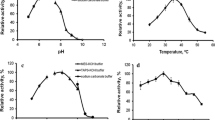Abstract
Sucrose’s ability to promote the hydroxylation of imidacloprid (IMI) by bacterium Stenotrophomonas maltophilia strain CGMCC 1.1788 was examined. Both growing culture and resting cells could transform IMI into 5-hydroxy IMI. Adding 2% sucrose to the growing culture transformation broth and 5% sucrose to the resting cell transformation broth resulted in biotransformation yields, respectively, 2.5 and 9 times greater than without sucrose. In the growing culture transformation, sucrose increased biomass, which led to enhance hydroxylation of IMI. In the resting cell transformation, sucrose was used not as a carbon source but as an energy source for cofactor regeneration for hydroxylation of IMI. The hydroxylation activity of IMI was promoted eightfold by adding reduced nicotinamide adenine dinucleotide (NADH) to the cell-free extract. The hydroxylation of IMI was significantly inhibited by P450 inhibitor piperonyl butoxide. It seems that the hydroxylation of IMI by S.maltophilia CGMCC 1.1788 might proceed through a system by cooperating with P450 enzyme.





Similar content being viewed by others
References
Asperger O, Steinbrenner H, Lehmann A, Petsch M, Griengl H (1999) Induction and functional role of cytochromes P450 in the filamentous fungi Mortierella alpine ATCC 8979 and Cunninghamella blakesleeana DSM 1906 during hydroxylation of cycloalkylbenzoxazoles. Appl Microbiol Biotechnol 51:516–522
Bradford M (1976) A rapid and sensitive method for the quantification of microgram quantities of protein utilizing the principle of protein dye binding. Anal Biochem 72:248–254
Dai YJ, Yuan S, Ge F, Chen T, Xu SC, Ni JP (2006) Microbial hydroxylation of imidacloprid for the synthesis of highly insecticidal olefin imidacloprid. Appl Microbiol Biotechnol 71:927–934
Dick R, Kanne D, Casida J (2005) Identification of aldehyde oxidase as the neonicotinoid nitroreductase. Chem Res Toxicol 18:317–323
Ernst M, Kaup B, Müller M, Bringer-Meyer S, Sahm H (2005) Enantioselective reduction of carbonyl compounds by whole-cell biotransformation, combining a formate dehydrogenase and a (R)-specific alcohol dehydrogenase. Appl Microbiol Biotechnol 66:629–634
Grosse S, Laramee L, Wendlandt K, Mcdonald I, Miguez C, Kleber H (1999) Purification and characterization of the soluble methane monooxygenase of the type II methanotrophic bacterium Methylocystis sp. Appl Environ Microbiol 65:3929–3935
Holland H, Weber H (2000) Enzymatic hydroxylation reactions. Curr Opin Biotechnol 11:547–553
Kagabu S, Kato C, Nishimura K (2004) Insecticidal and neuroblocking activities toward American cockroach (Periplaneta americana L.) of imidacloprid metabolites, 5-hydroxy-, 4, 5-dihydroxy- and 4,5-dehydroimidacloprid. J Pestic Sci 29:376–379
Krohn J, Hellpointner E (2002) Environmental fate of imidacloprid. Pflanzenschutz-Nachrichten Bayer 55 special edition:3–26
Lee N-R, Hwang M-O, Jung G-H, Kim Y-S, Min K-H (1996) Physical structure and expression of alkBA encoding alkane hydroxylase and rubredoxin reductase from Pseudomonas maltophilia. Biochem Biophys Res Commun 218:17–21
Lewis D, Hlavica P (2000) Interactions between redox partners in various cytochrome P450 systems: functional and structural aspects. Biochim Biophys Acta 1460:353–374
Matsuzaki F, Wariishi H (2004) Functional diversity of cutochrome P450s of the white-rot fungus Phanerochaete chrysosporium. Biochem Biophys Res Commun 324:387–393
Nagasawa T, Hurh B, Yamamne T (1994) Production of 6-hydroxynicotinic acid from nicotinic acid by resting cells of Pseudomonas fluorescens TN5. Biosci Biotech Biochem 58:665–668
Nauen R, Tietjen K, Wagner K, Elbert A (1998) Efficacy of plant metabolites of imidacloprid against Myzus persicae and Aphis gossypii (Homoptera: Aphididae). Pestic Sci 52:53–57
Nauen R, Rechmann U, Armborst S, Stupp HP, Elbert A (1999) Whitefly-active metabolites of imidacloprid: biological efficacy and translocation in cotton plants. Pestic Sci 55:265–271
Nauen R, Ebbinghaus-Kintscher U, Schmuck R (2001) Toxicity and nicotinic acetylcholine receptor interaction of imidacloprid and its metabolites in Apis mellifera (Hymenoptera: Apidae). Pest Manag Sci 57:577–586
Sachan A, Ghosh S, Mitra A (2006) Biotransformation of p-coumaric acid by Paecilomyces variotii. Lett Appl Microbiol 42:35–41
Schulz-Jander D, Casida J (2002) Imidacloprid insecticide metabolism: human cytochrome P450 isozymes differ in selectivity for imidazolidine oxidation versus nitroimine reduction. Toxicol Lett 132:65–70
Uchida A, Yoshida T, Ogawa M, Nagasawa T (2003) Regioselective hydroxylation of quinolinic acid, lutidinic acid and isocinchomeronic acid by resting cells of pyridine dicarboxylic acid-degrading microorganisms. Appl Microbiol Biotechnol 62:337–341
Urlacher V, Lutz-Wahl S, Schmid R (2004) Microbial P450 enzymes in biotechnology. Appl Microbiol Biotechnol 64:317–325
Yuan S, Yang Y, Sun J, Liang MX, Dai YJ, Zhang XN, Xu SC (2005) A combined process of hydroxylation of nicotinic acid by growing culture and hydroxylation of 3-cyanopyridine by resting cells of Comamonas testosteroni JA1. Eng Life Sci 5:369–374
Acknowledgment
We are thankful for the support from the Natural Science Foundation of Jiangsu, China (BK2006574), the Key Basic Research Program of the Jiangsu Higher Education Institutions of China (06KJA21016), and the Natural Science Foundation of the Jiangsu Higher Education Institutions of China (04KJB180071).
Author information
Authors and Affiliations
Corresponding author
Rights and permissions
About this article
Cite this article
Dai, Yj., Chen, T., Ge, F. et al. Enhanced hydroxylation of imidacloprid by Stenotrophomonas maltophilia upon addition of sucrose. Appl Microbiol Biotechnol 74, 995–1000 (2007). https://doi.org/10.1007/s00253-006-0762-2
Received:
Revised:
Accepted:
Published:
Issue Date:
DOI: https://doi.org/10.1007/s00253-006-0762-2




